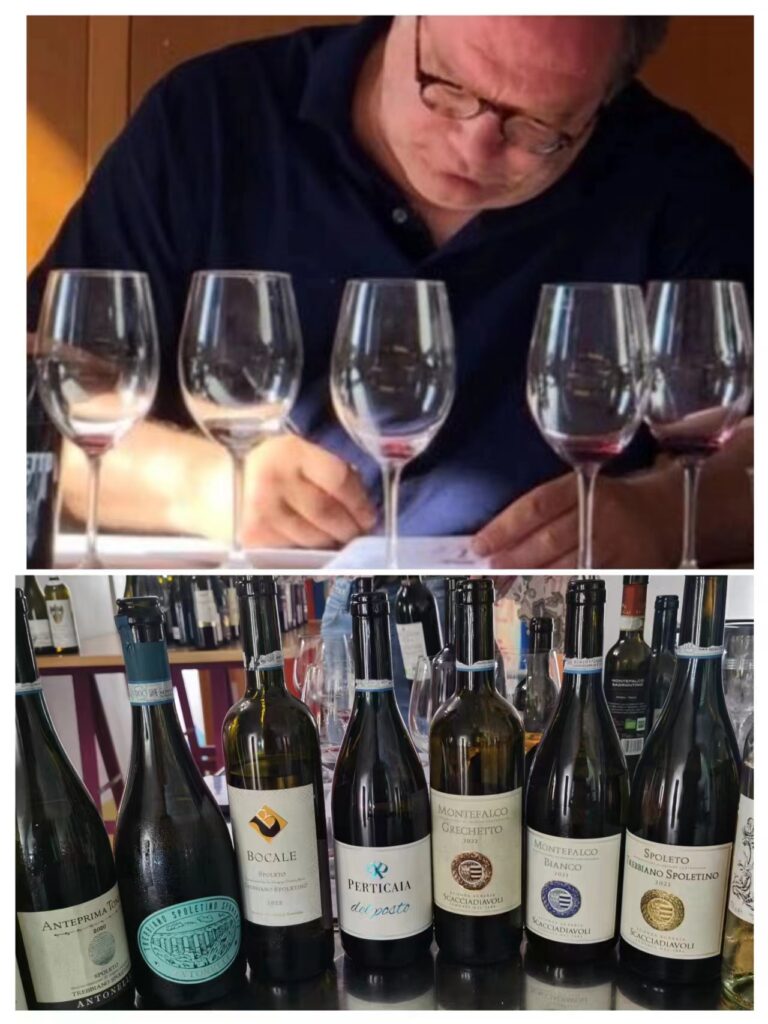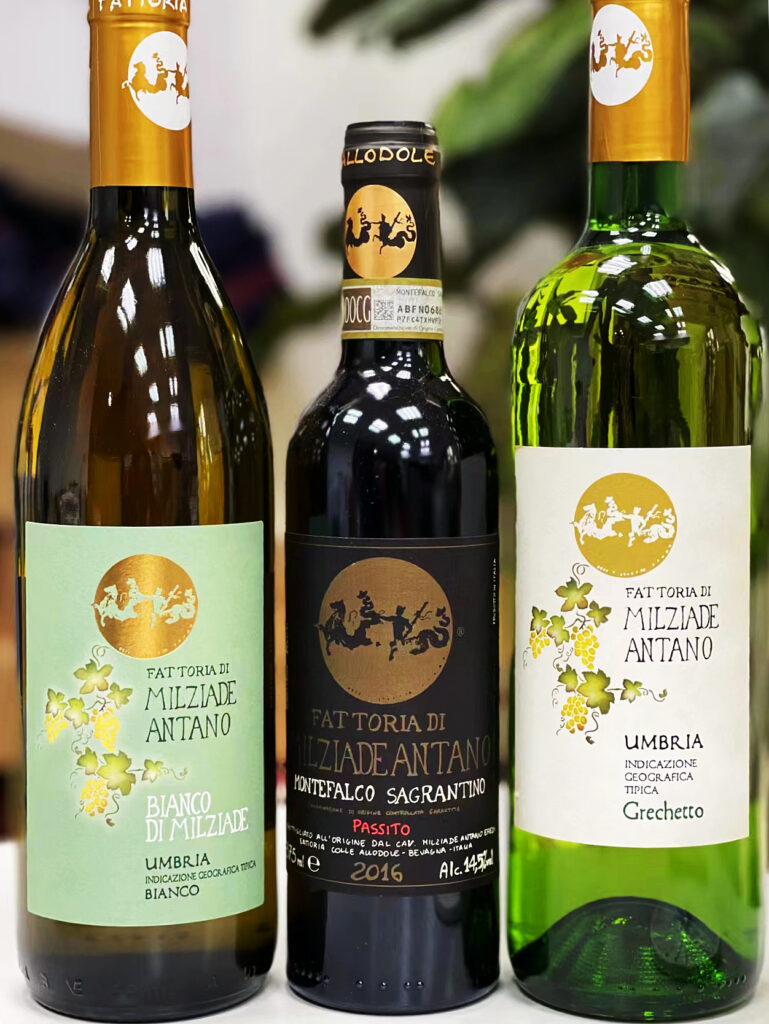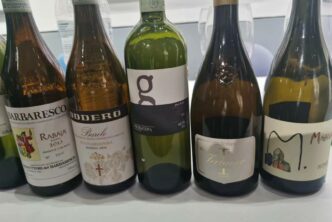Located roughly forty kilometers southeast of Perugia, Umbria’s biggest city, Montefalco is one of the many extremely pretty medieval towns that Italy is literally overrun with, to the point that what would be postcard-worthy and unforgettable vacation destinations in practically almost all the world’s other countries, in Italy these play second, if not third, fiddle to the likes of Venice, Rome and Florence. Not many of those who live outside of the ancient Enotria have ever been to, or are even aware of, the magnificent towns and cities of Ferrara, Ravenna, Lecce, Martinafranca, and many others.
Montefalco, originally called Coccorone (from Cors Coronae) had its name changed to the “mountain of the hawk” by Emperor Frederic II, who had observed many such birds living in the area (the actual legend that explains Montefalco’s name is actually a bit more complicated, but that’s a story for another time). Situated at 472 meters above sea level (some say 473 meters: well, I don’t know you, but I’m not the type to quibble) on top of a hill overlooking the valleys of the rivers Clitunno and Topino. From its belvedere (vantage point), Montefalco offers a truly beautiful panoramic view of the surrounding area, and a stroll around town (especially in the city’s downtown core centered around the beautiful little piazza del Comune, referred to as the platea rotunda in more ancient times) is a highly enjoyable ways to spend a Saturday in Italy (if you go, make sure you visit the fourteenth century San Francesco church, with artworks by Benozzo Gozzoli and the Perugino; but I also recommend going to the Church of Santa Chiara and of course the thirteenth century Palazzo Comunale). In fact, Montefalco is but one of the many pretty towns that are found within the borders of the Montefalco wine territory. Arguably (actually, not really soooo arguably) Bevagna, located to the north of Montefalco just ten-twelve minutes away by car, is even prettier (make sure you take a leisurely stroll down the Corso, the main street that takes you from one end of town to the next, the churches of San Michele and San Silvestro, the Palazzo Lepri and a walk around the town’s medieval fortified walls). Other towns that are the backbone of the Montefalco wine denomination include Gualdo Cattaneo, also to the north of Montefalco, and Castel Ritaldi and Giano dell’Umbria to the south.

Wine-wise, all these towns are famously associated with the Montefalco Sagrantino wine, which dukes it out with Friuli Venezia Giulia’s Pignolo grape for the title of “Italy’s most famous grape variety”. The wine is big, tannic and when well-vinified, the source of highly interesting reds, that provide quite a mouthful. Clearly, when vinifications are less than ideal, look out. In many respects, Montefalco’s most enjoyable wines are the easy-going, nicely approachable Montefalco Rosso and Rosso Riserva wines, blends of Sangiovese (mostly: 60-80%) with smaller percentages of Sagrantino (10-25%) plus others allowed in the regional list of wine grapes (most of the time, this means Merlot and/or Montepulciano). The most famous Montefalco wine of all was historically the Passito, a sweet red wine made by air-drying grapes. This was the most commonly found red wine of Montefalco denomination, which turned to making classically dry Sagrantino wines only very recently (the 1970s, as strange as that may seem nowadays). When well made, the Sagrantino Passito is still Montefalco’s best wine, marvellously sweet, luscious and well-balanced, but unfortunately sweet wine sales being what they are these days, has led a number lof local producers to abandon the tried-and-true in favour of making easier to understand big red wine. For more information on Sagrantino’s grapes and wines, I refer you to my article on Sagrantino published in 2022 here in the Terroir Sense Wine Review on June 15 2022: The wines of Montefalco: New and Recent Releases.
Montefalco’s white grapes
Not many know that Montefalco was conquered by the nearby Umbrian town of Todi back in 1280. I hear you thinking: Ian, I like wine and I read the TerroirSense Wine Review because of that, so what do we care about what Todi was thinking and doing centuries ago? Well, because if you can steal away from trying to identify seventeen different descriptors in every glass of wine you taste, then you have the time to learn that Todi’s overrunning of Montefalco goes along way in explaining why at least one grape, if not more, has long ruled the Montefalco area’s white wine grape scenario. That grape is the Grechetto di Todi, one of the two Grechetto varieties officially recognized in Italy (and that has been identified as being the same as Emilia Romagna’s Pignoletto variety. With the arrival of the Tuderte domination of Montefalco’s territory (tuderte as in “of Todi”), planting of this specific white variety took off; up until then, the bulk of Montefalco’s production area had been devoted to growing red grapes (Sagrantino, for the most part) and making red wines. So if you have ever wondered why a grape called Grechetto di Todi is so common in the Montefalco territory (rather than, say, Grtechetto di Montefalco), well, now you know. To a smaller extent, a second “Grechetto” grape variety is also grown in the Montefalco territory: the Grechetto di Orvieto, which is more typical and common of the Orvieto denomination (where Grechetto di Todi is also grown). But while historically the Grechettos were the Montefalco area’s most important white grapes, today another white grape has emerged from the doldrums of the past and is playing an increasingly important role: Trebbiano Spoletino. This is the only Trebbiano variety to be related to another in the Trebbiano group (Trebbiano Spoletino is a relative of the rare Trebbiano Abruzzese), and like the latter grape, its is a high-quality wine grape: its wines have nothing in common with those made with the lowly Trebbiano Toscano and Trebbiano Romagnolo, for example. However, there is much confusion surrounding Trebbiano Spoletino, with wines made by some producers fairly aromatic in nature and others not much at all (I always use the world “aromatic” in its precise enological context, meaning a wine expressing noteworthy concentrations of terpenic molecules: such aromatic Trebbiano Spoletino wines can best be thought of as being somewhat Muscat-like, but never so potent). I for one am not entirely sure producers are all using one and the same grape, especially those with older vineyards of the stuff. (I have walked Montefalco’s vineyards numerous times and can vouch to have observed at least six or seven very different-looking “Trebbiano Spoletino” grapes, and so I wonder.) For the most part, when similarly-made, outside of the aforementioned greater or lesser degree of aromatic oomph, Trebbiano Spoletino wines resemble each other, exuding notes of lime (especially), honey, and white flowers. I state “when similarly made”, because some producers have taken to macerating their Trebbiano Spoletino grapes at length, making macerated/orange wines that do little to clarify what the grape’s wines are really supposed to smell and taste like. Clearly, those laughable wines that smell and taste of Sauvignon Blanc (admittedly more common once than they are nowadays) aren’t worth a second of your time or a cent out of your wallet. But to be clear, Trebbiano Spoletino wines, when well-made by competent producers, are actually amongst Italy’s biggest wine success stories of the last fifteen-twenty years.

The wines
Today, Montefalco Bianco wines have to be made with no less than 50% Trebbiano Spoletino; before the changes were made to the official production guidelines starting with the 2016 vintage, the blend was Grechetto grapes (not less than 50%) and Trebbiano Toscano (20-35%), plus up to 30% other grapes allowed in the region, including things like Chardonnay. Montefalco Grechetto wines have to be at least 85% Grechetto varieties. The wine called Trebbiano Spoletino Spoleto has to be made with 85% that grape variety: other Spoleto white wines allowed now are the Spoleto Bianco (minimum 50% Trebbiano Spoletino), and Trebbiano Spoletino Superiore and Trebbiano Spoletino Passito (both at least 85% Trebbiano Spoletino). Most importantly, the changes made to the official production guidelines that went into effect with the 2016 vintage now determine that these white wines have to be bottles within the jurisdiction of the specific wine production zone, a highly qualitative move and a guarantee for wine lovers everywhere. In other words, you won’t be buying any authentic Trebbiano Spoletino Spoleto or Montefalco Grechetto wines that have been bought in Italy and bottled in Germany or Norway. And that has a whole lot of meaning and ramifications.
In summary…
In ultimate analysis, while the Montefalco wine territory is mostly famous for its very big, powerfully tannic, wines made with Sagrantino, it actually offers wine lovers so much more. The white wines are underrated. The Grechetto wines are some of the most improved white wines in all Italy, and have never been better. Those made with Trebbaino Spoletino have the potential to rank amongst Italy’s very best and most interesting, and you’ll immediately understand why I say that when you come across a good one. Unfortunately, this grape has been the subject of some wildly different vinifications of late which run the risk of confusing the wine-loving public making it difficult to build up a large consumer base of fans. Going forward, this is something people need to give some serious thought to in the Denominazione: the best Trebbiano Spoletino wines are, by far, those that are made as classic white wines and showcase the variety’s truly amazing, even unique, capacity to express notes of lime in all its potential expressions (fresh lime, candied lime, lime nectar, lime cordial). When that happens, Trebbiano Spoletino are like, the true Carricante wines of Etna (not the Carricante blends, which are mostly pedestrian) absolutely like no other white wine in the world, and it seems foolish to me to throw that potential away by wanting to macerate or do other stuff to the poor grape. Last and most definitely least, the Montefalco wines are a hodge-podge of many different things: although there are some good, even fun, wines being made in that category, the majority differ wildly one from the other, and so rather than expressing any semblance of a “Montefalco somewhereness”, are best thought of as exercises in creative freedom, something Italians just always so love to do. Good for them. It’s a relatively new category of wine that has been greatly improved with the changes to its production guidelines that now bring Trebbiano Spoletino to the fore. By contrast, there are no such concerns with Sagrantino Passito, one of the world’s greatest sweet wines, and that ranks right up there with Port, Maury, Banyuls and Recioto della Valpolicella as one of the most interesting and worthwhile sweet red wines in the world. Get a hold of some of the good one Sagrantino Passitos described in this article, pair them with rich stews, aged cheeses (blue cheeses too) and any thick chocolate dessert you can think of (I said “thick”, so not chocolate mousse: chocolate brownies and dark chocolate flourless cakes are ideal) and get ready to love your life.
The wines in this tasting report.
All the wines in this report were tasted in Italy last September in Rome. The majority of the wines in this report were obtained through Diana Cataldo of Miriade & Partners to whom I extend my personal thank-you (Diana and her team work with the association of Montefalco producers in promoting the territory and its wines). A few other Montefalco wines were tasted in my office in Shanghai.

 English
English




Ian,
Thanks for elaborating on the many differences among the white wines of Montefalco. I recall from my visit there several years ago that I was impressed with many of the white wines that we sampled, not expecting much from them at all. Of course, a well made Sagrantino can be a transcendent experience, but as you point out in the hands of a winemaker with a passion for bianco, they can also be excellent. It continues to amaze me the vast number of cultivars that are present in Italy, and how in the right hands these wines can be so enjoyable, and high quality. I think another trip to Umbria is long overdue, since the food is spectacular, the wine is getting better and better, and it is one of the most charming regions in Italy.
Ciao there, I really couldn’t agree with you more. Wine-wise Umbria is a little forgotten, while it certainly is an everyday tourist mecca given important and gorgeous towns like Assisi, Spoleto, Gubbio, Todi and more. But I’m with you, both white and red wines have a lot to say. The Grechetto wines have never been better, and Trebbiano Spoletino is areal eye-opener, just one of many Italian native cultivars that were once forgotten but have remerged with very convincing wines. I also think the region is lovely, very green and it’s truly beautiful place to visit and taste the wines and food of.
By the way, speaking of gorgeous regions and good wines, for more on wines from rare and at times forgotten native grapes, both red and white, check my Friday article on the Wines of Campania, there’s some real stunners there too. Cheers!
Ian